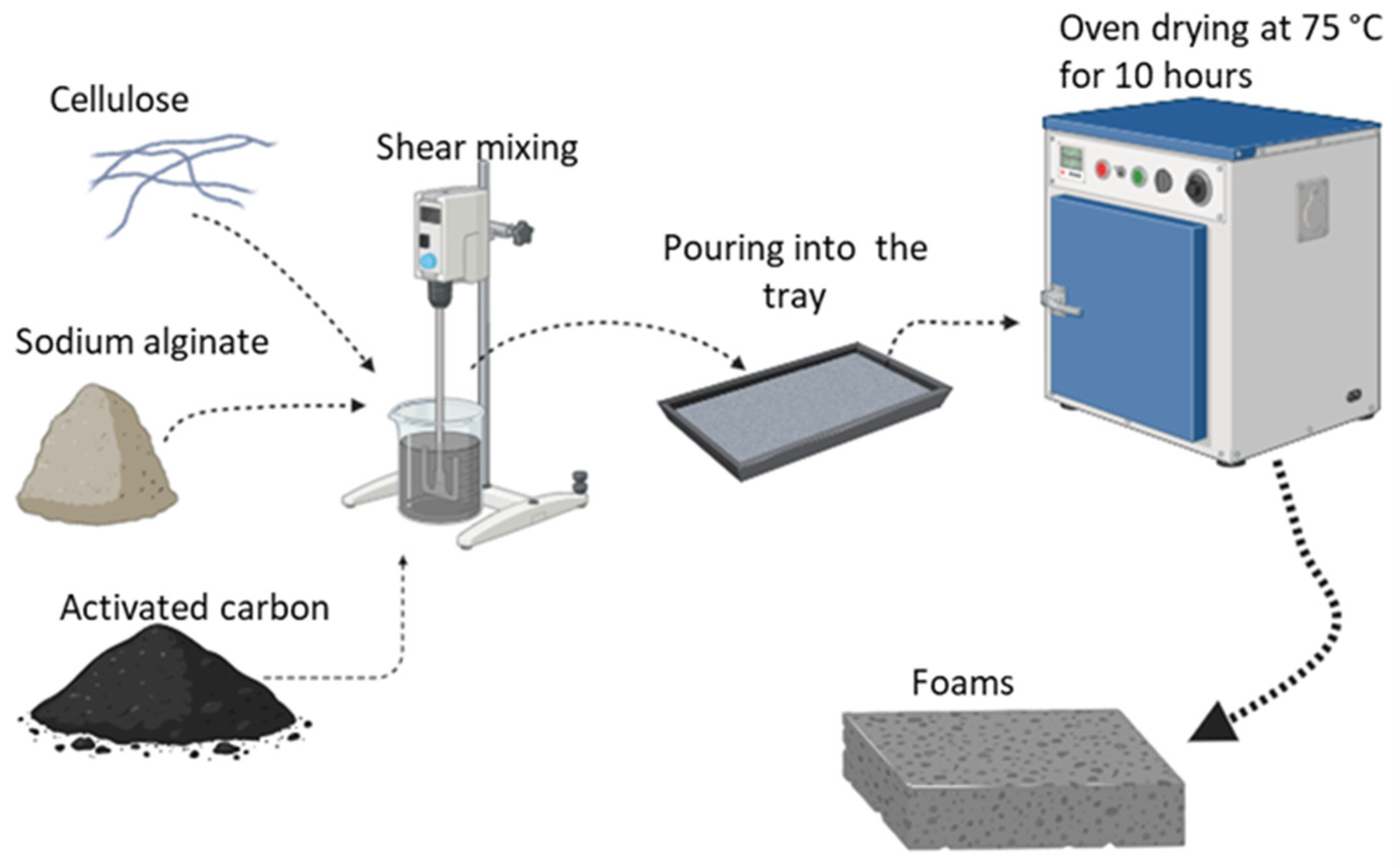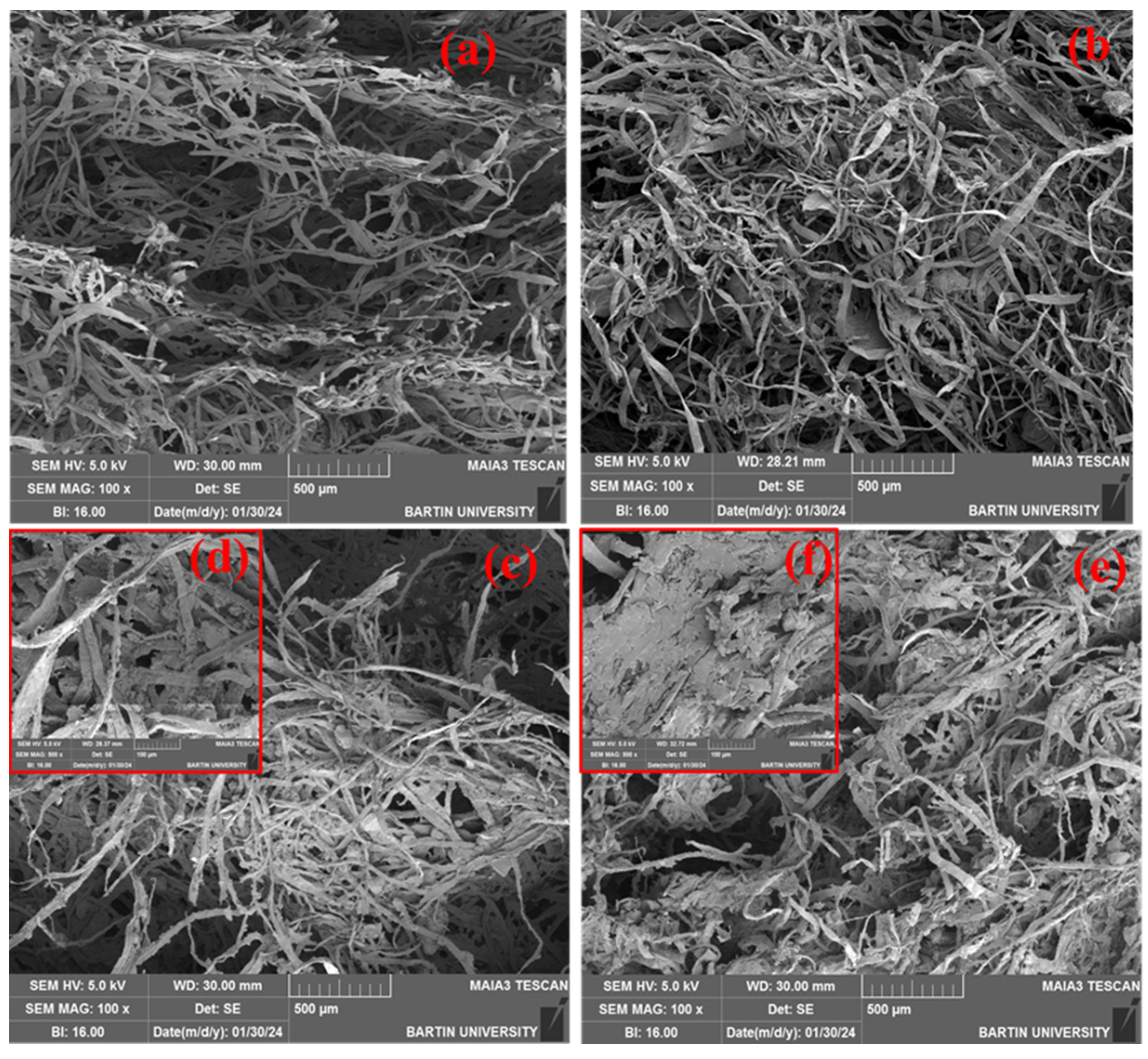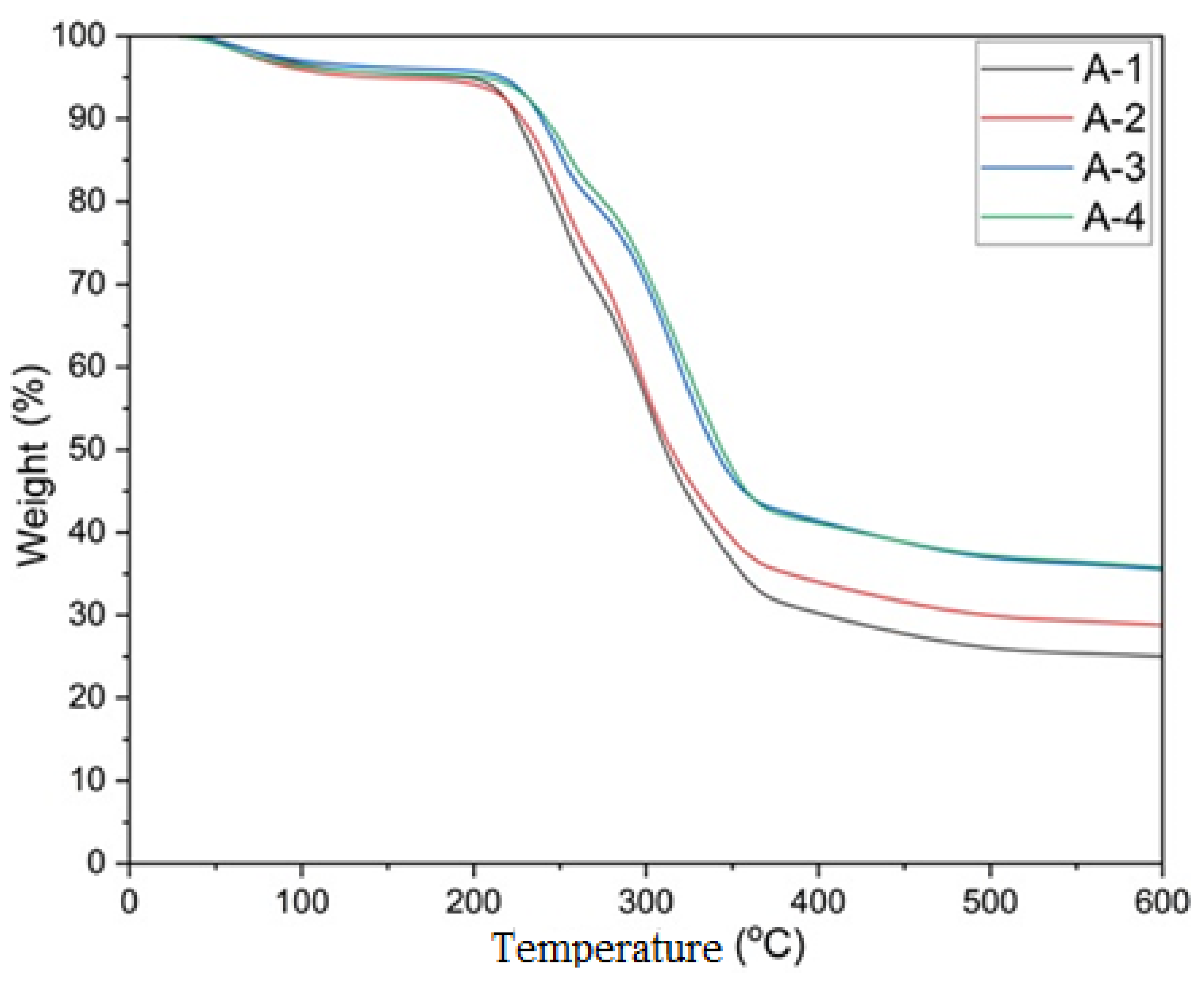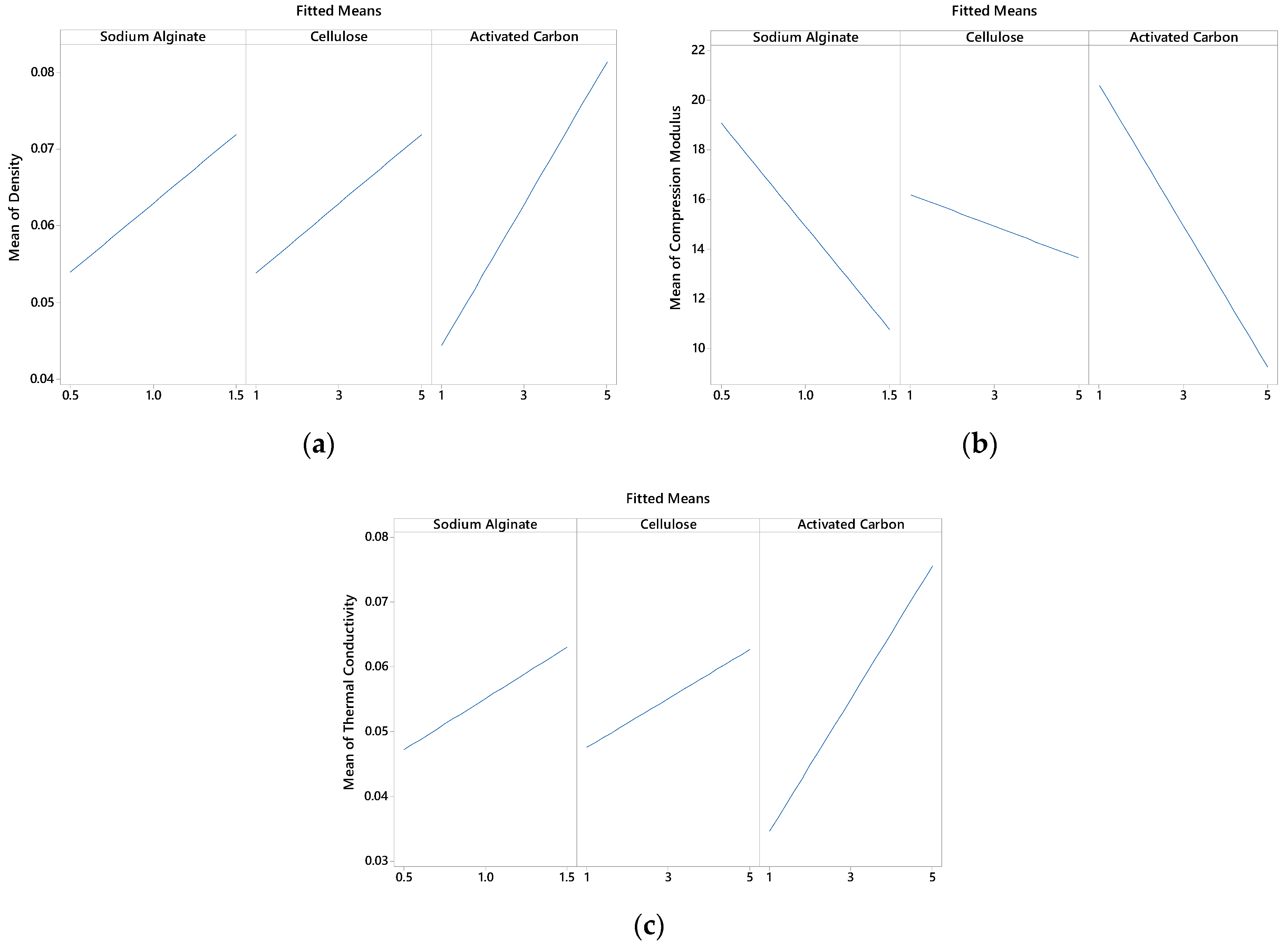Optimized Eco-Friendly Foam Materials: A Study on the Effects of Sodium Alginate, Cellulose, and Activated Carbon
Abstract
:1. Introduction
2. Materials and Methods
2.1. Materials
2.2. Production Process of Sodium Alginate-Based Foam
2.3. Characterization of Sodium Alginate-Based Foam
2.4. Box–Behnken Design
3. Results and Discussion
Statistical Analysis and Optimization
4. Conclusions
Author Contributions
Funding
Institutional Review Board Statement
Data Availability Statement
Conflicts of Interest
References
- Wu, G.; Xie, P.; Yang, H.; Dang, K.; Xu, Y.; Sain, M.; Turng, L.-S.; Yang, W. A Review of Thermoplastic Polymer Foams for Functional Applications. J. Mater. Sci. 2021, 56, 11579–11604. [Google Scholar] [CrossRef]
- Khemani, K.C. Polymeric Foams: An Overview. In Polymeric Foams; ACS Symposium Series; American Chemical Society: Washington, DC, USA, 1997; Volume 669, pp. 1–7. ISBN 978-0-8412-3516-8. [Google Scholar]
- Reynoso, L.E.; Carrizo Romero, Á.B.; Viegas, G.M.; San Juan, G.A. Characterization of an Alternative Thermal Insulation Material Using Recycled Expanded Polystyrene. Constr. Build. Mater. 2021, 301, 124058. [Google Scholar] [CrossRef]
- Lee, S.T. Introduction: Polymeric Foams, Mechanisms, and Materials. In Polymeric Foams; Lee, S.T., Ramesh, N.S., Eds.; CRC Press: Boca Raton, FL, USA, 2004; ISBN 978-0-429-21120-1. [Google Scholar] [CrossRef]
- Aram, E.; Mehdipour-Ataei, S. A Review on the Micro- and Nanoporous Polymeric Foams: Preparation and Properties. Int. J. Polym. Mater. Polym. Biomater. 2016, 65, 358–375. [Google Scholar] [CrossRef]
- Perera, K.Y.; Jaiswal, A.K.; Jaiswal, S. Biopolymer-Based Sustainable Food Packaging Materials: Challenges, Solutions, and Applications. Foods 2023, 12, 2422. [Google Scholar] [CrossRef]
- Svagan, A.J.; Samir, M.A.S.A.; Berglund, L.A. Biomimetic Foams of High Mechanical Performance Based on Nanostructured Cell Walls Reinforced by Native Cellulose Nanofibrils. Adv. Mater. 2008, 20, 1263–1269. [Google Scholar] [CrossRef]
- Ergun, M.E. Activated Carbon and Cellulose-Reinforced Biodegradable Chitosan Foams. BioRes 2023, 18, 1215–1231. [Google Scholar] [CrossRef]
- Ottenhall, A.; Seppänen, T.; Ek, M. Water-Stable Cellulose Fiber Foam with Antimicrobial Properties for Bio Based Low-Density Materials. Cellulose 2018, 25, 2599–2613. [Google Scholar] [CrossRef]
- Ergün, M.E.; Ergun, H. Investigating the Feasibility of Guar Gum-Based Foams for Insulation Applications Using Regression Analysis. DYNA Ing. Ind. 2023, 98, 566–571. [Google Scholar] [CrossRef] [PubMed]
- Berglund, L.; Nissilä, T.; Sivaraman, D.; Komulainen, S.; Telkki, V.-V.; Oksman, K. Seaweed-Derived Alginate–Cellulose Nanofiber Aerogel for Insulation Applications. ACS Appl. Mater. Interfaces 2021, 13, 34899–34909. [Google Scholar] [CrossRef]
- Ahmad, A.; Mubarak, N.M.; Jannat, F.T.; Ashfaq, T.; Santulli, C.; Rizwan, M.; Najda, A.; Bin-Jumah, M.; Abdel-Daim, M.M.; Hussain, S.; et al. A Critical Review on the Synthesis of Natural Sodium Alginate Based Composite Materials: An Innovative Biological Polymer for Biomedical Delivery Applications. Processes 2021, 9, 137. [Google Scholar] [CrossRef]
- Motloung, M.P.; Ojijo, V.; Bandyopadhyay, J.; Ray, S.S. Cellulose Nanostructure-Based Biodegradable Nanocomposite Foams: A Brief Overview on the Recent Advancements and Perspectives. Polymers 2019, 11, 1270. [Google Scholar] [CrossRef] [PubMed]
- Lin, N.; Chen, Y.; Hu, F.; Huang, J. Mechanical Reinforcement of Cellulose Nanocrystals on Biodegradable Microcellular Foams with Melt-Compounding Process. Cellulose 2015, 22, 2629–2639. [Google Scholar] [CrossRef]
- Pan, J.; Chen, F.; Cabrera, E.D.; Min, Z.; Ruan, S.; Wu, M.; Zhang, D.; Castro, J.M.; Lee, L.J. Carbon Particulate and Controlled-Hydrolysis Assisted Extrusion Foaming of Semi-Crystalline Polyethylene Terephthalate for the Enhanced Thermal Insulation Property. J. Cell. Plast. 2021, 57, 695–716. [Google Scholar] [CrossRef]
- Dbik, A.; El Messaoudi, N.; Bentahar, S.; El Khomri, M.; Lacherai, A.; Faska, N. Optimization of Methylene Blue Adsorption on Agricultural Solid Waste Using Box–Behnken Design (BBD) Combined with Response Surface Methodology (RSM) Modeling. Biointerface Res. Appl. Chem. 2021, 12, 4567–4583. [Google Scholar] [CrossRef]
- Kurt, R.; Ergun, H.; Ergun, M.E.; Istek, A. Box–Behnken Experimental Design for Optimization of Chitosan Foam Materials Reinforced with Cellulose and Zeolite. Biofuels Bioprod. Biorefin. 2024, 18, 1107–1120. [Google Scholar] [CrossRef]
- Yildirim, N.; Ozen, E.; Ergun, M.E.; Dalkilic, B. A Study on Physical, Morphological and Antibacterial Properties of Bio Polymers Reinforced Polyvinyl Acetate Foams. Mat. Res. 2022, 25, e20210579. [Google Scholar] [CrossRef]
- Husainie, S.M.; Deng, X.; Ghalia, M.A.; Robinson, J.; Naguib, H.E. Natural Fillers as Reinforcement for Closed-Molded Polyurethane Foam Plaques: Mechanical, Morphological, and Thermal Properties. Mater. Today Commun. 2021, 27, 102187. [Google Scholar] [CrossRef]
- Ergun, M.E.; Ergun, H. Influence of Activated Carbon Concentration on Foam Material Properties: Design and Optimization. Arab. J. Sci. Eng. 2024, 49, 4877–4888. [Google Scholar] [CrossRef]
- ASTM C518; Standard Test Method for Steady-State Thermal Transmission Properties by Means of the Heat Flow Meter Apparatus. American Society for Testing and Materials: West Conshohocken, PA, USA, 2021.
- ASTM C165-07; Standard Test Method for Measuring Compressive Properties of Thermal Insulations. American Society for Testing and Materials: West Conshohocken, PA, USA, 2017.
- ASTM C303; Standard Test Method for Dimensions and Density of Preformed Block and Board–Type Thermal Insulation. American Society for Testing and Materials: West Conshohocken, PA, USA, 2010.
- Gumustas, M.; Caglayan, M.G.; Onur, F.; Ozkan, S.A. Simultaneous Determination and Validation of Emtricitabine, Rilpivirine and Tenofovir from Biological Samples Using LC and CE Methods. Biomed. Chromatogr. 2018, 32, e4158. [Google Scholar] [CrossRef]
- Nguyen, N.-K.; Borkowski, J.; Vuong, M.P. Perspective Chapter: Cyclic Generation of Box-Behnken Designs and New Second-Order Designs. In Response Surface Methodology—Research Advances and Applications; Kayarogannam, P., Ed.; IntechOpen: London, UK, 2023; ISBN 978-1-83880-288-2. [Google Scholar] [CrossRef]
- Ghanimati, M.; Abdoli-Senejani, M.; Bodaghifard, M.A.; Momeni Isfahani, T. Phosphomolybdic Acid Immobilized Chitosan/Fe3O4: An Efficient Catalyst for the N-Alkylation of Anilines. Eurasian Chem. Commun. 2020, 2, 688–701. [Google Scholar] [CrossRef]
- Kamala Kumari, P.V.; Yarraguntla, S.R.; Sharmila, M.; Harika, V. Application of Box-Behnken Design for Formulation Parameters of Eslicarbazepine Tablets. Indian J. Pharm. Sci. 2021, 83, 575–583. [Google Scholar] [CrossRef]
- Shin, D.-S.; Jeon, E.-S.; Kim, Y.-S. Numerical Estimation of Bonding Force of EPDM Grommet Parts with Hollow Shaft Geometry. Appl. Sci. 2020, 10, 3169. [Google Scholar] [CrossRef]
- Ergün, H.; Ergün, M.E. Modeling Xanthan Gum Foam’s Material Properties Using Machine Learning Methods. Polymers 2024, 16, 740. [Google Scholar] [CrossRef]
- Ullah, N.; Ali, Z.; Khan, A.S.; Adalat, B.; Nasrullah, A.; Khan, S.B. Preparation and Dye Adsorption Properties of Activated Carbon/Clay/Sodium Alginate Composite Hydrogel Membranes. RSC Adv. 2024, 14, 211–221. [Google Scholar] [CrossRef] [PubMed]
- Dash, R.; Li, Y.; Ragauskas, A.J. Cellulose Nanowhisker Foams by Freeze Casting. Carbohydr. Polym. 2012, 88, 789–792. [Google Scholar] [CrossRef]
- Li, R.; Du, J.; Zheng, Y.; Wen, Y.; Zhang, X.; Yang, W.; Lue, A.; Zhang, L. Ultra-Lightweight Cellulose Foam Material: Preparation and Properties. Cellulose 2017, 24, 1417–1426. [Google Scholar] [CrossRef]
- Li, B.; Qiu, L.; Zhang, J.; Liu, S.; Xu, M.; Wang, J.; Yang, H. Solubilization of Chitosan in Biologically Relevant Solvents by a Low-Temperature Solvent-Exchange Method for Developing Biocompatible Chitosan Materials. Int. J. Biol. Macromol. 2024, 254, 127950. [Google Scholar] [CrossRef]
- Chueangchayaphan, W.; Nooun, P.; Ummarat, N.; Chueangchayaphan, N. Eco-Friendly Biocomposite Foam from Natural Rubber Latex and Rice Starch for Sustainable Packaging Applications. Express Polym. Lett. 2024, 18, 27–40. [Google Scholar] [CrossRef]
- Karkeh-abadi, F.; Saber-Samandari, S.; Saber-Samandari, S. The Impact of Functionalized CNT in the Network of Sodium Alginate-Based Nanocomposite Beads on the Removal of Co(II) Ions from Aqueous Solutions. J. Hazard. Mater. 2016, 312, 224–233. [Google Scholar] [CrossRef]
- Yang, G.; Zhang, L.; Peng, T.; Zhong, W. Effects of Ca2+ Bridge Cross-Linking on Structure and Pervaporation of Cellulose/Alginate Blend Membranes. J. Membr. Sci. 2000, 175, 53–60. [Google Scholar] [CrossRef]
- Augst, A.D.; Kong, H.J.; Mooney, D.J. Alginate Hydrogels as Biomaterials. Macromol. Biosci. 2006, 6, 623–633. [Google Scholar] [CrossRef] [PubMed]
- Sakhiya, A.K.; Anand, A.; Vijay, V.K.; Kaushal, P. Thermal Decomposition of Rice Straw from Rice Basin of India to Improve Energy-Pollution Nexus: Kinetic Modeling and Thermodynamic Analysis. Energy Nexus 2021, 4, 100026. [Google Scholar] [CrossRef]
- Javni, I.; Song, K.; Lin, J.; Petrovic, Z.S. Structure and Properties of Flexible Polyurethane Foams with Nano- and Micro-Fillers. J. Cell. Plast. 2011, 47, 357–372. [Google Scholar] [CrossRef]
- Chen, C.-X.; Huang, B.; Li, T.; Wu, G.-F. Preparation of Phosphoric Acid Activated Carbon from Sugarcane Bagasse by Mechanochemical Processing. BioResources 2012, 7, 5109–5116. [Google Scholar] [CrossRef]
- Xu, H.; Liu, C.; Guo, W.; Li, N.; Chen, Y.; Meng, X.; Zhai, M.; Zhang, S.; Wang, Z. Sodium Alginate/ Al2O3 Fiber Nanocomposite Aerogel with Thermal Insulation and Flame Retardancy Properties. Chem. Eng. J. 2024, 489, 151223. [Google Scholar] [CrossRef]
- Ergun, M.E.; Ozen, E.; Yildirim, N.; Dalkilic, B.; Baysal, E. Mechanical and Thermal Properties of Polyvinyl Acetate Foams Reinforced with Biopolymers. Cell. Polym. 2023, 42, 156–173. [Google Scholar] [CrossRef]
- Li, Y.; Liu, X.; Nie, X.; Yang, W.; Wang, Y.; Yu, R.; Shui, J. Multifunctional Organic–Inorganic Hybrid Aerogel for Self-Cleaning, Heat-Insulating, and Highly Efficient Microwave Absorbing Material. Adv. Funct. Mater. 2019, 29, 1807624. [Google Scholar] [CrossRef]
- Liu, H.; Zhao, X. Thermal Conductivity Analysis of High Porosity Structures with Open and Closed Pores. Int. J. Heat Mass Transf. 2022, 183, 122089. [Google Scholar] [CrossRef]
- Li, M.-E.; Wang, S.-X.; Han, L.-X.; Yuan, W.-J.; Cheng, J.-B.; Zhang, A.-N.; Zhao, H.-B.; Wang, Y.-Z. Hierarchically Porous SiO2/Polyurethane Foam Composites towards Excellent Thermal Insulating, Flame-Retardant and Smoke-Suppressant Performances. J. Hazard. Mater. 2019, 375, 61–69. [Google Scholar] [CrossRef]
- Schiavoni, S.; D׳Alessandro, F.; Bianchi, F.; Asdrubali, F. Insulation Materials for the Building Sector: A Review and Comparative Analysis. Renew. Sustain. Energy Rev. 2016, 62, 988–1011. [Google Scholar] [CrossRef]
- Al-Homoud, M.S. Performance Characteristics and Practical Applications of Common Building Thermal Insulation Materials. Build. Environ. 2005, 40, 353–366. [Google Scholar] [CrossRef]
- Explanations on Some Features of EPS. Available online: https://styrosan.com.tr/epsnin-bazi-ozellikleriyle-ilgili-aciklamalar/ (accessed on 30 August 2024).
- Saiz-Arroyo, C.; de Saja, J.A.; Rodríguez-Pérez, M.A. Production and Characterization of Crosslinked Low-Density Polyethylene Foams Using Waste of Foams with the Same Composition. Polym. Eng. Sci. 2012, 52, 751–759. [Google Scholar] [CrossRef]
- Thirumal, M.; Khastgir, D.; Singha, N.K.; Manjunath, B.S.; Naik, Y.P. Effect of Foam Density on the Properties of Water Blown Rigid Polyurethane Foam. J. Appl. Polym. Sci. 2008, 108, 1810–1817. [Google Scholar] [CrossRef]
- Hung Anh, L.D.; Pásztory, Z. An Overview of Factors Influencing Thermal Conductivity of Building Insulation Materials. J. Build. Eng. 2021, 44, 102604. [Google Scholar] [CrossRef]
- Hu, F.; Wu, S.; Sun, Y. Hollow-Structured Materials for Thermal Insulation. Adv. Mater. 2019, 31, 1801001. [Google Scholar] [CrossRef] [PubMed]
- Moeini Sedeh, M.; Khodadadi, J.M. Thermal Conductivity Improvement of Phase Change Materials/Graphite Foam Composites. Carbon 2013, 60, 117–128. [Google Scholar] [CrossRef]
- Mougel, C.; Garnier, T.; Cassagnau, P.; Sintes-Zydowicz, N. Phenolic Foams: A Review of Mechanical Properties, Fire Resistance and New Trends in Phenol Substitution. Polymer 2019, 164, 86–117. [Google Scholar] [CrossRef]
- Chawla, N.; Chawla, K.K. Microstructure-Based Modeling of the Deformation Behavior of Particle Reinforced Metal Matrix Composites. J. Mater. Sci. 2006, 41, 913–925. [Google Scholar] [CrossRef]
- Chowdhury, F.I.; Rahman, M.R.; Islam, J. Chapter 12—Cellulose-Based Foaming Materials. In Fundamentals and Recent Advances in Nanocomposites Based on Polymers and Nanocellulose; Rahman, M.R., Ed.; Elsevier: Amsterdam, The Netherlands, 2022; pp. 207–242. ISBN 978-0-323-85771-0. [Google Scholar]
- Sethi, S.; Ray, B.C. Environmental Effects on Fibre Reinforced Polymeric Composites: Evolving Reasons and Remarks on Interfacial Strength and Stability. Adv. Colloid Interface Sci. 2015, 217, 43–67. [Google Scholar] [CrossRef]
- Lin, J.-C. Compression and Wear Behavior of Composites Filled with Various Nanoparticles. Compos. Part B Eng. 2007, 38, 79–85. [Google Scholar] [CrossRef]
- Oberth, A.E. Principle of Strength Reinforcement in Filled Rubbers. Rubber Chem. Technol. 1967, 40, 1337–1363. [Google Scholar] [CrossRef]








| Codes | Parameters | Levels | ||
|---|---|---|---|---|
| −1 | 0 | 1 | ||
| A | Sodium Alginate (%) | 0.5 | 1 | 1.5 |
| B | Cellulose (%) | 1 | 3 | 5 |
| C | Activated Carbon (%) | 1 | 3 | 5 |
| Codes | Sodium Alginate (%) | Cellulose (%) | Activated Carbon (%) | Sodium Alginate (%) | Cellulose (%) | Activated Carbon (%) |
|---|---|---|---|---|---|---|
| 1 | −1 | −1 | 0 | 0.5 | 1 | 3 |
| 2 | 1 | −1 | 0 | 1.5 | 1 | 3 |
| 3 | −1 | 1 | 0 | 0.5 | 5 | 3 |
| 4 | 1 | 1 | 0 | 1.5 | 5 | 3 |
| 5 | −1 | 0 | −1 | 0.5 | 3 | 1 |
| 6 | 1 | 0 | −1 | 1.5 | 3 | 1 |
| 7 | −1 | 0 | 1 | 0.5 | 3 | 5 |
| 8 | 1 | 0 | 1 | 1.5 | 3 | 5 |
| 9 | 0 | −1 | −1 | 1.0 | 1 | 1 |
| 10 | 0 | 1 | −1 | 1.0 | 5 | 1 |
| 11 | 0 | −1 | 1 | 1.0 | 1 | 5 |
| 12 | 0 | 1 | 1 | 1.0 | 5 | 5 |
| 13 | 0 | 0 | 0 | 1.0 | 3 | 3 |
| 14 | 0 | 0 | 0 | 1.0 | 3 | 3 |
| 15 | 0 | 0 | 0 | 1.0 | 3 | 3 |
| Codes | Ti% (°C) | Tmax% (°C) | Char Yields (%) |
|---|---|---|---|
| A-1 | 225 | 311 | 24.96 |
| A-2 | 227 | 314 | 28.67 |
| A-3 | 238 | 339 | 35.33 |
| A-4 | 241 | 343 | 35.62 |
| Sodium Alginate (%) | Cellulose (%) | Activated Carbon (%) | Density (g/cm3) | Compression Modulus (MPa) | Thermal Conductivity W/mK |
|---|---|---|---|---|---|
| 0.5 | 1 | 3 | 0.0400 | 0.0454 | 0.0356 |
| 1.5 | 1 | 3 | 0.0597 | 0.0601 | 0.0513 |
| 0.5 | 5 | 3 | 0.0687 | 0.0615 | 0.0595 |
| 1.5 | 5 | 3 | 0.0803 | 0.3455 | 0.0781 |
| 0.5 | 3 | 1 | 0.0313 | 0.0371 | 0.0275 |
| 1.5 | 3 | 1 | 0.0513 | 0.0545 | 0.0413 |
| 0.5 | 3 | 5 | 0.0723 | 0.0679 | 0.0731 |
| 1.5 | 3 | 5 | 0.0930 | 0.1136 | 0.0883 |
| 1.0 | 1 | 1 | 0.0430 | 0.0574 | 0.0412 |
| 1.0 | 5 | 1 | 0.0583 | 0.0557 | 0.0430 |
| 1.0 | 1 | 5 | 0.0797 | 0.7057 | 0.0738 |
| 1.0 | 5 | 5 | 0.0877 | 0.0975 | 0.0821 |
| 1.0 | 3 | 3 | 0.0593 | 0.0601 | 0.0438 |
| Property | Eco-Friendly Foam (Current Study) | Polyurethane Foam | Polystyrene Foam | Polyethylene Foam |
|---|---|---|---|---|
| Density (g/cm3) | 0.0313–0.0930 | 0.028 [45] | 0.016–0.061 [46] | 0.035–0.040 [47] |
| Compression Modulus (MPa) | 0.0371–0.7057 | 0.42 [45] | 0.6–3.1 [48] | 0.7–4.20 [49] |
| Thermal Conductivity (W/mK) | 0.0275–0.0883 | 0.031 [45] | 0.033–0.040 [46] | 0.041 [47] |
| Source | Density | ||||
| df | SS | MS | F-Value | p-Value | |
| Model | 3 | 0.004071 | 0.001357 | 46.54 | 0.000 |
| Linear | 3 | 0.004071 | 0.001357 | 46.54 | 0.000 |
| SA | 1 | 0.000648 | 0.000648 | 22.23 | 0.001 |
| C | 1 | 0.000660 | 0.000660 | 22.64 | 0.001 |
| AC | 1 | 0.002763 | 0.002763 | 94.76 | 0.000 |
| Error | 11 | 0.000321 | 0.000029 | - | - |
| Lack-of-Fit | 9 | 0.000276 | 0.000031 | 1.37 | 0.491 |
| Pure Error | 2 | 0.000045 | 0.000022 | - | - |
| Total | 14 | 0.004391 | - | - | - |
| Source | Compression Modulus | ||||
| df | SS | MS | F-Value | p-Value | |
| Model | 9 | 516.195 | 57.355 | 2.54 | 0.158 |
| Linear | 3 | 409.837 | 136.612 | 6.05 | 0.041 |
| SA | 1 | 138.464 | 138.464 | 6.13 | 0.056 |
| C | 1 | 12.841 | 12.841 | 0.57 | 0.485 |
| AC | 1 | 258.532 | 258.532 | 11.45 | 0.020 |
| Square | 3 | 71.387 | 23.796 | 1.05 | 0.446 |
| SA × SA | 1 | 9.150 | 9.150 | 0.41 | 0.552 |
| C × C | 1 | 55.010 | 55.010 | 2.44 | 0.179 |
| AC × AC | 1 | 4.580 | 4.580 | 0.20 | 0.671 |
| 2-Way Interaction | 3 | 34.972 | 11.657 | 0.52 | 0.689 |
| SA × C | 1 | 15.910 | 15.910 | 0.70 | 0.439 |
| SA × AC | 1 | 1.789 | 1.789 | 0.08 | 0.790 |
| C × AC | 1 | 17.272 | 17.272 | 0.77 | 0.422 |
| Error | 5 | 112.868 | 22.574 | - | - |
| Lack-of-Fit | 3 | 106.983 | 35.661 | 12.12 | 0.077 |
| Pure Error | 2 | 5.884 | 2.942 | - | - |
| Total | 14 | 629.063 | - | - | - |
| Source | Thermal Conductivity | ||||
| df | SS | MS | F-Value | p-Value | |
| Model | 3 | 0.004333 | 0.001444 | 19.91 | 0.000 |
| Linear | 3 | 0.004333 | 0.001444 | 19.91 | 0.000 |
| SA | 1 | 0.000502 | 0.000502 | 6.93 | 0.023 |
| C | 1 | 0.000462 | 0.000462 | 6.36 | 0.028 |
| AC | 1 | 0.003369 | 0.003369 | 46.44 | 0.000 |
| Error | 11 | 0.000798 | 0.000073 | - | - |
| Lack-of-Fit | 9 | 0.000789 | 0.000088 | 18.96 | 0.051 |
| Pure Error | 2 | 0.000009 | 0.000005 | - | - |
| Total | 14 | 0.005131 | - | - | - |
Disclaimer/Publisher’s Note: The statements, opinions and data contained in all publications are solely those of the individual author(s) and contributor(s) and not of MDPI and/or the editor(s). MDPI and/or the editor(s) disclaim responsibility for any injury to people or property resulting from any ideas, methods, instructions or products referred to in the content. |
© 2024 by the authors. Licensee MDPI, Basel, Switzerland. This article is an open access article distributed under the terms and conditions of the Creative Commons Attribution (CC BY) license (https://creativecommons.org/licenses/by/4.0/).
Share and Cite
Ergün, M.E.; Kurt, R.; Can, A.; Özlüsoylu, İ.; Ersoy Kalyoncu, E. Optimized Eco-Friendly Foam Materials: A Study on the Effects of Sodium Alginate, Cellulose, and Activated Carbon. Polymers 2024, 16, 2511. https://doi.org/10.3390/polym16172511
Ergün ME, Kurt R, Can A, Özlüsoylu İ, Ersoy Kalyoncu E. Optimized Eco-Friendly Foam Materials: A Study on the Effects of Sodium Alginate, Cellulose, and Activated Carbon. Polymers. 2024; 16(17):2511. https://doi.org/10.3390/polym16172511
Chicago/Turabian StyleErgün, Mehmet Emin, Rıfat Kurt, Ahmet Can, İsmail Özlüsoylu, and Evren Ersoy Kalyoncu. 2024. "Optimized Eco-Friendly Foam Materials: A Study on the Effects of Sodium Alginate, Cellulose, and Activated Carbon" Polymers 16, no. 17: 2511. https://doi.org/10.3390/polym16172511







